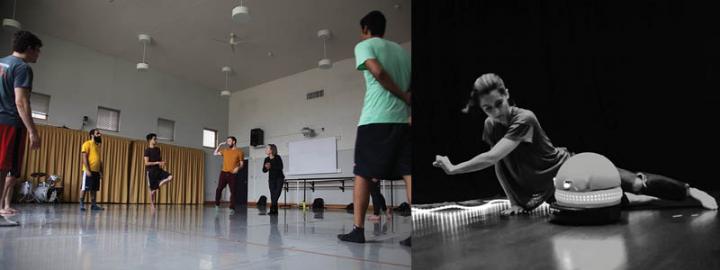
Credit: Photo by Keira Heu-Jwyn Chang.
University of Illinois researcher Amy LaViers has introduced a new point of view from which to observe robotic capabilities in her paper, “Counts of Mechanical, External Configurations Compared to Computational, Internal Configurations in Natural and Artificial Systems,” published today in PLOS ONE, a leading interdisciplinary research journal.
LaViers leads the Robotics, Automation, and Dance (RAD) Lab, which specializes in the development of expressive robotic systems. Typically, robots aim to replicate some form of natural motion or action. In industry settings such as manufacturing or warehouse inventory, robots are typically far better performing with higher accuracy, precision, and lower cost over time. In more dynamic situations however, natural systems are more likely to outperform a robot. The performance of controlled tasks, for example, much of what is seen in a warehouse, can be easily quantified, but when it comes to the more complex situations there hasn’t been a good way to do so. LaViers’ paper introduces a simplified counting model that gives numerical perspective to compare the expressive capabilities of robots and natural beings. This is a topic that is explored in the RAD Lab through interdisciplinary collaboration with artists and somatic practice.
In computing there are many variables that go into the power of a device, but a common way of modeling it uses the number of transistors that device has. Over time, the number of transistors has increased and so has the computing power, a trend that is often referred to as Moore’s Law. A parallel can be drawn to natural systems between transistors being “on” and “off” and a simplified model of neurons: “firing” and “not firing.” Such a transistor count gives a static bottleneck for computational capacity of computers, ignoring dynamic aspects of processor speed, for example. LaViers noticed that a similar count of static external configurations of robots could reveal trends in robotic capacity. Moreover, she linked computation and mechanization in a robot to internal and external state changes, respectively, in a natural organism. After making these comparisons, LaViers can directly compare how expressive robots are to natural organisms as shown in the plot below.
Her paper focuses on two models of a microscopic worm (C. Elegans) and several partial organism analyses as well as analysis of a variety of well-known modern robots. A graph of LaViers’ findings show that, using her method, the robots perform mostly between the two models of the worm for how expressive they are. That is, an apt natural correlate for the expressivity of extant robotic systems may be this tiny worm. The comparisons are not perfect, but they provide a simplification of a complex problem in order to understand the bigger picture – how much progress can be made in the realm of robotics in dynamic situations.
In the field of robotics, the advantages of nature sometimes get overlooked. LaViers’ work contextualizes the progress made by roboticists over the years. Robots have become far more advanced, but when it comes to true imitation of nature there is still much to do. The groundbreaking aspect of her current work is that this particular counting model has not been used before in robotics.
“What I’m proud of with this paper is that the trends revealed are a little shocking to people – and it has taken a long time to get published because of that,” LaViers said. “The reviewers at this venue were extremely helpful in making the paper stronger. In the end, the work is hopefully pointing to a way of thinking about artificial versus natural systems that can help us improve failure and robustness of machines in dynamic environments. That’s the direction for future work.”
###
Media Contact
Amy LaViers
[email protected]
Original Source
https:/
Related Journal Article
http://dx.



